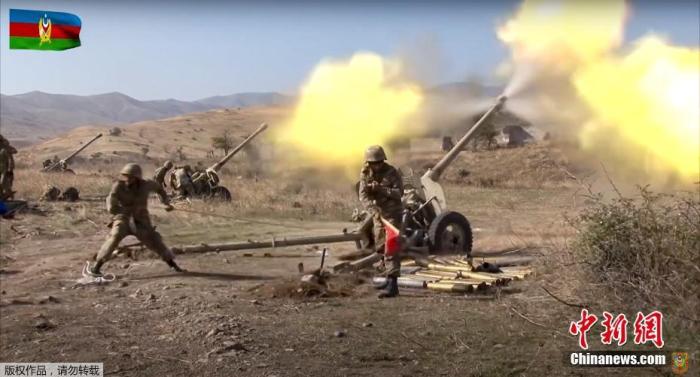Azerbaijan and Armenia Geneva peace talks progress hard
The foreign ministers of Azerbaijan and Armenia held talks in Geneva, Switzerland on October 30. They did not reach a new ceasefire agreement on the conflict between the two countries in the Nagorno-Karabakh (Naka) area, but promised to ease tensions, including not targeting civilians. Attack and exchange the remains of prisoners and fallen soldiers.
Data map: On October 20, local time, the picture released by the Ministry of Defense of Azerbaijan that day showed that Azerbaijani artillery troops fired violently on targets in the Naka region. The Azerbaijani side stated that parts of its territory were also shelled by Armenia that day.
[Small progress]
The co-chairs of the Minsk Group of the Organization for Security and Cooperation in Europe mediating the Naka issue said in a statement on the 30th that Armenian Foreign Minister Zograb Mnatsakkanyan and Azerbaijani Foreign Minister Jehon Bayramov have resolved the issue. The Naka conflict met face-to-face in Geneva for 6 hours.
The OSCE statement stated that Azerbaijan and Armenia "frankly exchanged a large number of views with a view to clarifying their respective positions" and "reached an agreement on a series of urgent issues," including a commitment to "abide by international humanitarian law and not target civilians or non-military targets." Launch an attack", agreed to exchange the remains of the dead soldiers to give the ICRC personnel safety guarantee.
The two parties promised to hand over the list of prisoners to the Red Cross within a week to promote the exchange of detainees.
Deutsche News Agency reported that the Naka conflict has resulted in the death of more than 1,000 civilians.
The Naka region is located in southwestern Azerbaijan, and its residents are mostly Armenians.
After the disintegration of the Soviet Union, Azerbaijan and Armenia broke out due to the question of the ownership of the Naka region. After that, they remained hostile for a long time, and conflicts occurred from time to time.
In 1992, under the initiative of Russia, the Conference on Security and Cooperation in Europe (the predecessor of the OSCE) established a Minsk group composed of 12 countries, with Russia, the United States, and France as co-chairs.
Since then, negotiations on the Naka issue at different levels have been held within the framework of the Minsk Group, but no substantial progress has been made.
[Difficult to break through]
The OSCE statement issued on October 30 did not mention that Azerbaijan and Armenia reached a new round of ceasefire agreements.
The conflict between Azerbaijan and Armenia in the Naka region broke out on September 27 and lasted for more than a month.
The two countries reached a ceasefire agreement on October 10, 17 and 25 respectively, but shortly after the agreement came into effect, each other accused each other of breaking the ceasefire.
Agence France-Presse reported that the foreign ministers of the two countries were originally scheduled to arrive in Geneva on the 29th to start a new round of diplomatic negotiations, which was postponed due to the outbreak of conflict in Naqqa.
The OSCE said that during the dialogue on the 30th, the OSCE has repeatedly urged Azerbaijan and Armenia to reach a ceasefire agreement.
Kyrie Kavanaugh, co-chair of the Minsk Group, a representative of the United States, posted a message on social media Twitter: “Without a feasible ceasefire, the likelihood of civilian casualties is increasing day by day.”
The President of Azerbaijan, Ilham Aliyev, said earlier this week that he is not opposed to the Geneva dialogue, but does not have much expectations. “There have been too many meaningless meetings in the past 28 years.”
Armenian Prime Minister Nicole Pashinyan said on October 21 that the Naka issue cannot be resolved through diplomatic channels at this stage, and this situation will continue for a long time.
(Cuckoo)

